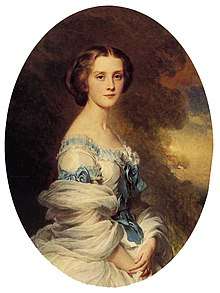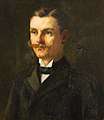Mélanie de Pourtalès
Mélanie de Pourtalès, Countess Edmond de Pourtalès (née Louise Sophie Mélanie Renouard de Bussière) (26 March 1836 – 5 May 1914) was a French salonniére and courtier.
Mélanie, Comtesse Edmond de Pourtalès | |
|---|---|
 Portrait of the Comtesse by Winterhalter, 1857 | |
| Born | Louise Sophie Mélanie Renouard de Bussière 26 March 1836 |
| Died | 5 May 1914 (aged 78) |
| Known for | Lady-in-waiting to Empress Eugénie |
| Spouse(s) | Count Edmond de Pourtalès
( m. 1857; died 1895) |
| Children | 5 |
| Parent(s) | Sophie Mélanie de Coehoorn Baron Alfred Renouard de Bussière |
Early life
.jpg)
She was born on 26 March 1836 at the Château de Robertsau in Strasbourg, to the former Sophie Mélanie de Coehoorn (1802–1880), and Baron Alfred Renouard de Bussière (1804–1887), who was from a wealthy Strasbourg industrial family.[1] He was director of the Royal Mint of Strasbourg from 1834 to 1860, before being appointed head of the Royal Mint of Paris.[2]
Her paternal grandparents were Athanase Paul Renouard, Vicomte de Boussière and the former Friederike Wilhelmine von Franck. Her uncle was Léon Renouard de Bussierre. Her maternal grandparents were Louis Jacques, Baron de Coehoorn and the former Marie Margarethe Sophie von Beyer.[3][4]
Courtier
She was introduced to the French imperial court by the Austrian ambassador, Richard von Metternich, and appointed as lady-in-waiting to the empress, Eugénie de Montijo, the wife of Napoleon III.[5]
Pourtalès' salon was regarded as one of the most famed during the Second French Empire, when she was one of the leading figures in Parisian high society and imperial court life.[6] In her letters, she writes about the pending marriage of Antonin-Just-Léon-Marie de Noailles, Duc de Mouchy to the Princess Anne Murat, daughter of Prince Lucien Murat and granddaughter of the King of Naples Joachim Murat and Queen Caroline (younger sister of the Emperor Napoleon).[6]
According to French writer Alfred Mézières, "three people saw clearly what was coming before 1870, Lieutenant-Colonel Stoffel, General Ducrot, and Madame de Pourtalès."[6][lower-alpha 1]
Personal life
On 30 June 1857, she married banker Count Edmond de Pourtalès (1828–1895), a son of Count James-Alexandre de Pourtalès of the Château de Gorgier, a prominent banker and art collector who had served as chamberlain the King of Prussia Frederick William III. Count Edmond's elder sister, Élisa de Pourtalès was the wife of French diplomat Charles-Alexandre, Marquis de Ganay. Together, they were the parents of:[8]
- Jacques de Pourtalès (1858–1919), who married Jacqueline Conquerré de Montbrison (1871–1925), later the Countess Wladimir Rehbinder after their divorce.[9][10]
- Paul de Pourtalès (1859–1933), a Saint-Cyrien, politician and head of the Longchamp Racecourse.[11]
- Hubert Louis Edmond de Pourtalès (1863–1949),[12] who married Marguerite de Schickler (1870–1956), a daughter of Arthur, Baron von Schickler.[13][14] Hubert owned Château Martinvast in Normandy, the "most famous racing establishment and stud farm in France."[11][15]
- Élisabeth de Pourtalès (1867–1952), who married Christian Egenolf François, Baron de Berckheim (1853–1935), a grandson of the Marquis de Jaucourt, in 1886.[16]
- Mélanie Agnès de Pourtalès (1870–1930), who in 1890 married the equally wealthy Henri, Marquis de Löys-Chandieu, who had been engaged to Victoria Sackville-West before her marriage to Baron Sackville.[17][18]
The Count de Pourtalès died in 1895. The Countess died on 5 May 1914. After her death, her daughter Agnès inherited the Château de la Robertsau.[18]
Residences
From her father, she inherited the family's château, the Château de la Robertsau (which today is known as the Château de Pourtalès) in the département of Bas-Rhin, Alsace.[19] At their château, they hosted Franz Liszt, Napoléon III, Empress Eugénie, the Princes of Belgium and Russia, Ludwig I of Bavaria, the Grand Duke of Baden and the Princess Metternich.[1]
Her husband inherited the Pourtalès mansion, a hôtel particulier (essentially a grand townhouse) on Rue Tronchet in the 6th arrondissement of Lyon that was built for his father between 1838 and 1839 by Félix Duban.[20][21]
Descendants
Through her youngest daughter Agnès, she was a grandmother of Edmée de Loys-Chandieu (1892–1945), who married Alexander, Count of Hoyos, son of Georg Anton, Count of Hoyos and the former Alice Whitehead (daughter of British engineer Robert Whitehead). Alexander's aunt, Marguerite, was married to Herbert von Bismarck, the eldest son of Chancellor Otto von Bismarck.[22] Edmée's daughter, Melanie Hoyos, also married a member of the Bismarck family, Count Gottfried von Bismarck-Schönhausen, and their descendants include Stephanie zu Guttenberg.[23]
- Gallery
 Portrait of Comtesse de Pourtalès by Pierre-Auguste Renoir, 1877
Portrait of Comtesse de Pourtalès by Pierre-Auguste Renoir, 1877 Portrait of her son, Count Hubert de Pourtalès, by Marguerite Schickler de Pourtalès, 1892
Portrait of her son, Count Hubert de Pourtalès, by Marguerite Schickler de Pourtalès, 1892 Portrait of her daughter-in-law, Marguerite, Comtesse Hubert de Pourtalès, by Lucien Lévy-Dhurmer
Portrait of her daughter-in-law, Marguerite, Comtesse Hubert de Pourtalès, by Lucien Lévy-Dhurmer Her daughter, Agnès de Pourtalès, Marquise de Loys-Chandieu, by Ernest Hébert
Her daughter, Agnès de Pourtalès, Marquise de Loys-Chandieu, by Ernest Hébert
References
- Notes
- The Siege of Paris, which began in 1870, led to the capture of the city by Prussian forces, which led to French defeat in the Franco-Prussian War and the establishment of the German Empire as well as the Paris Commune.[7]
- Sources
- "The history of the Château de Pourtalès". www.chateau-pourtales.eu. Retrieved 10 May 2020.
- Flandreau, Marc; Flandreau, Professor of Economics Marc (2004). Or Du Monde. OUP Oxford. p. 136. ISBN 978-0-19-925786-7. Retrieved 10 May 2020.
- Noack, Lothar; Splett, Jürgen (2015). Berlin-Cölln 1640–1688 (in German). Walter de Gruyter GmbH & Co KG. p. 541. ISBN 978-3-05-007177-0. Retrieved 10 May 2020.
- Beschreibende Darstellung der älteren Bau- und Kunstdenkmäler des Königreichs Sachsen (in German). In Kommission bei C.C. Meinhold. 1908. p. 353. Retrieved 10 May 2020.
- Robert Grossmann: Comtesse de Pourtalès. (Une cour française dans l'Alsace impériale 1836 – 1870 – 1914). Préface de Philippe Séguin. La Nuée Bleue, Strasbourg 1995, ISBN 2-7165-0369-9.
- Lobée, Frédéric Auguste (1907). Women of the Second Empire: Chronicles of the Court of Napoleon III. John Lane. Retrieved 10 May 2020.
- "No. 1132: The Siege of Paris". www.uh.edu. Archived from the original on 29 March 2016. Retrieved 7 May 2018.
- Melville Amadeus Henry Douglas Heddle de La Caillemotte de Massue de Ruvigny Ruvigny and Raineval (9th marquis of) (1914). The Titled Nobility of Europe: An International Peerage, Or "Who's Who", of the Sovereigns, Princes and Nobles of Europe. Harrison & Sons. p. 1172. Retrieved 10 May 2020.
- Tout-Paris (in French). A. La Fare. 1905. p. 472. Retrieved 10 May 2020.
- Proust, Marcel (2017). Letters to His Neighbor. New Directions Publishing. p. 109. ISBN 978-0-8112-2412-3. Retrieved 10 May 2020.
- "COUNT PAUL DE POURTALES; Head of Longchamps Racetrack a Member of Old Swiss Family". The New York Times. 27 October 1933. Retrieved 10 May 2020.
- N.Y.), Metropolitan Museum of Art (New York; Cavallo, Adolph S. (1993). Medieval Tapestries in the Metropolitan Museum of Art. Metropolitan Museum of Art. p. 121. ISBN 978-0-87099-644-3. Retrieved 10 May 2020.
- Recueil des décisions des tribunaux arbitraux mixtes, institués par les traités de paix, publié sous le haut patronage de mm (in French). Librairie de la Société du recueil Sirey, L. Tenin, directeur. 1925. p. 750. Retrieved 10 May 2020.
- "Collection Schickler-Pourtalès Art and Power in the XIXth Century". www.sothebys.com. Sothebys. 16 May 2019. Retrieved 10 May 2020.
- Birkhead, May (11 November 1934). "HUNTS MEETS LURE PARISIAN SOCIETY; Good Riders Turn to Events at Chantilly and Rambouillet as Longchamp Races End". The New York Times. Retrieved 10 May 2020.
- Bell, Esther Susan (2016). The Brothers Le Nain: Painters of Seventeenth-century France. Yale University Press. p. 226. ISBN 978-0-300-21888-6. Retrieved 10 May 2020.
- Sackville-West, Robert (2015). The Disinherited: A Story of Family, Love and Betrayal. Bloomsbury Publishing USA. p. 110. ISBN 978-1-63286-043-9. Retrieved 10 May 2020.
- Pinçon, Michel; Pinçon, Monique (1999). Grand Fortunes: Dynasties of Wealth in France. Algora Publishing. p. 135. ISBN 978-1-892941-18-3. Retrieved 10 May 2020.
- "The History of the Château de Pourtalès". studyabroad-france.eu. European Study Center in Strasbourg, France. Retrieved 10 May 2020.
- "Pourtalès, James Alexandre de". hls-dhs-dss.ch (in French). Dictionnaire Historique de la Suisse. Retrieved 9 May 2020.
- "Comte James Alexandre de Pourtalès-Gorgier | Collections Online". www.britishmuseum.org. British Museum. Retrieved 9 May 2020.
- Thies, Jochen (2013). Die Bismarcks: eine deutsche Dynastie (in German). Piper. pp. 186, 212, 389. ISBN 978-3-492-05503-1. Retrieved 10 May 2020.
- Proust, Marcel (2017). Auf der Suche nach der verlorenen Zeit. Gesamtausgabe: Bände 1–8: Vollständige Textausgabe mit Kommentarband (in German). Reclam Verlag. p. 3683. ISBN 978-3-15-961800-5. Retrieved 10 May 2020.